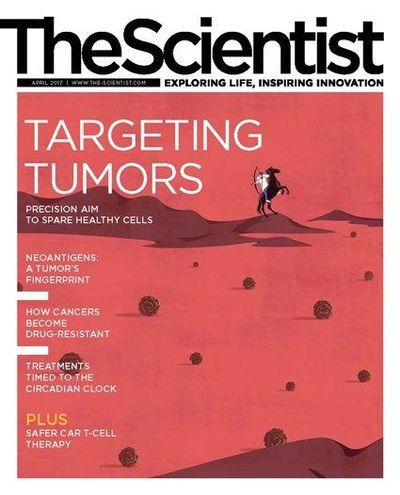 © TIM VERNON/SCIENCE SOURCEImmunotherapy has revolutionized the fight against cancer. People who otherwise would have had little hope of survival are experiencing extraordinary comebacks when treated with a class of medicines called checkpoint inhibitors. The inhibitors disable a molecular disguise that cancer cells use to hide from the immune system, allowing a patient’s own defenses to destroy tumors.
© TIM VERNON/SCIENCE SOURCEImmunotherapy has revolutionized the fight against cancer. People who otherwise would have had little hope of survival are experiencing extraordinary comebacks when treated with a class of medicines called checkpoint inhibitors. The inhibitors disable a molecular disguise that cancer cells use to hide from the immune system, allowing a patient’s own defenses to destroy tumors.
Although clearly transformative, these innovative treatments have faced challenges integrating within the framework of personalized oncology. Personalized treatments have traditionally been prescribed based on the presence of a single genetic vulnerability, but in immunotherapy the formula is not so simple. Each person’s immune system is wired slightly differently, giving it a unique degree of sensitivity to cancer. Currently, only about 20 percent to 40 percent of patients respond to the most effective combination of two checkpoint inhibitor immunotherapies.
Determining who will benefit from immunotherapy is an enormous challenge. But...
Predicting success with PD-L1
The current standard for predicting responses to checkpoint inhibitor immunotherapies is through the measurement of a protein biomarker called PD-L1—one of the molecular cloaks that hide cancer cells from the immune system. Tumors that produce high levels of PD-L1 generally respond more favorably to anti-PD-1/anti-PD-L1 checkpoint inhibitor immunotherapies than do tumors with lower levels of PD-L1 (or none at all).
Despite its broad acceptance and application, PD-L1 abundance has proven an inconsistent biomarker because of its dynamic expression on both tumor and immune cells and a lack of standardization across PD-L1–detection tests. This biological variability and the subjective thresholds used to determine a positive outcome make it difficult to accurately stratify patients, and may actually affect whether a clinical trial succeeds. For example, if the threshold for PD-L1 expression level is set too low, then not enough people in a trial may respond to the treatment. Indeed, the recent failure of a lung cancer trial has been linked to the inclusion of patients with PD-L1 levels that were too low to make them likely candidates for response.
For immunotherapy, we will need to look at multiple biomarkers—in addition to PD-L1—to determine which approach is right for each patient and each tumor type.
Getting quantitative
Fortunately, advances in next-generation sequencing, including the development of comprehensive genomic profiling (CGP), have enabled the discovery of new biomarkers that are more rigorous and quantitative, such as microsatellite instability (MSI) and tumor mutational burden (TMB). Rather than focusing on a single protein marker, CGP-measured MSI and TMB are based on quantifying the genomic changes associated with a given tumor.
MSI measures the accumulation of short, repeated sequences of DNA caused by defects in a specific type of DNA repair. In certain cases, “high” MSI can be a predictor for response to checkpoint inhibitor immunotherapy. For example, colorectal cancer patients who are MSI-high have been found more likely to respond to anti-PD-1 treatment.
Biological variability and the subjective thresholds used to determine a positive outcome make it difficult to accurately stratify patients.
TMB offers a quantitative measure of the total number of mutations in the coding regions of a tumor’s genome. Tumor cells that have higher levels of TMB—meaning they harbor more mutations—are believed to have more proteins on their surfaces that are distinct from those on a person’s healthy cells. These mutated proteins, known as neoantigens, are like red flags that can activate the immune system. Therefore, having high TMB may lead to a more robust immune response to checkpoint inhibitors. (See “Seek and Destroy,” here.)
There is a growing body of data demonstrating the utility of TMB as a predictive biomarker in advanced cancer. In fact, studies have shown that TMB can help predict responses to US Food and Drug Administration-approved checkpoint inhibitor immunotherapies across multiple tumor types, including lung cancer, melanoma, and bladder cancer. In a bladder cancer study, researchers found that TMB was superior to PD-L1 testing as a means of predicting and stratifying responses to an anti-PD-L1 immunotherapy.
And while PD-L1 testing may be applicable only to checkpoint inhibitors that target the protein and its receptor, TMB has the potential to predict response and guide treatment to any cancer therapy that relies on immune activation, such as T-cell therapies or cancer vaccines. Together with comprehensive genomic profiling, TMB may provide an opportunity for physicians treating patients with advanced-stage cancers to find new treatment options.
The path forward
There is still a need for more diagnostic biomarkers in advanced cancer. One example that illustrates this need is triple-negative breast cancer. This malignancy is not very noticeable to the immune system, so many people have hypothesized that immunotherapies wouldn’t work well. But it turns out that the presence of specific immune cells, called tumor-infiltrating lymphocytes, could help predict patient response to the combination of checkpoint inhibitor immunotherapy and chemotherapy, suggesting yet another predictive biomarker for immunotherapies.
While the incredible complexity of the human immune system poses a challenge to the development of biomarkers for immunotherapies, we are hopeful that we will continue to identify multiple biomarkers to guide the selection of the right treatment for the right patient. The potential for immunotherapies to change the cancer treatment landscape is clear. Now we need the right markers to help guide the way.
David Fabrizio is the cancer immunotherapy leader at Foundation Medicine, which offers a full suite of comprehensive genomic profiling assays to physicians.
Interested in reading more?




